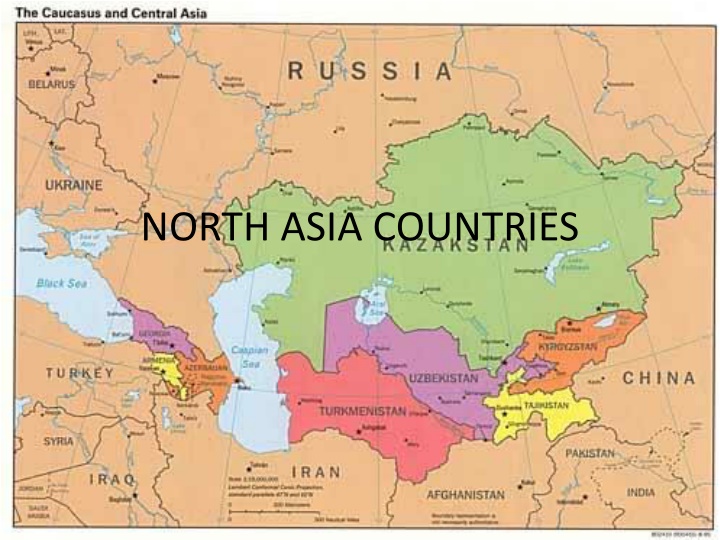Flags and Meanings of North Asian Countries
Explore the significance and meanings behind the flags of Armenia, Azerbaijan, Georgia, Kazakhstan, and Kyrgyzstan. Learn about the symbolism of colors, historical backgrounds, and cultural influences reflected in each flag design.
Download Presentation

Please find below an Image/Link to download the presentation.
The content on the website is provided AS IS for your information and personal use only. It may not be sold, licensed, or shared on other websites without obtaining consent from the author.If you encounter any issues during the download, it is possible that the publisher has removed the file from their server.
You are allowed to download the files provided on this website for personal or commercial use, subject to the condition that they are used lawfully. All files are the property of their respective owners.
The content on the website is provided AS IS for your information and personal use only. It may not be sold, licensed, or shared on other websites without obtaining consent from the author.
E N D
Presentation Transcript
There are conflicting views on the meaning of the Armenian flag's colors. The most recognized meaning of the Armenian flag is that the red symbolizes the blood spilt by Armenian soldiers in defense of their country; the orange symbolizes the fertile soil and the farmers that work on it; and the blue represents the sky. Another theory states that the colors mean: red - the sun's energy; blue - the clear sky; and orange - the wheat at harvest.
Blue represents the aspiration to Turkization; Green represents the aspiration to Islamization; Red represents the aspiration to modernization and progress, following the European example.
The central design element of the "Five Cross" flag is the St. George Cross in the middle of it. The St. George Cross is still used as the national flag of England. St George is the patron saint of Georgia. According to Georgian scholar Giorgi Gabeskiria, the four small crosses were probably added during the reign of Giorgi V who drove out the Mongols. Around that era, the new flag design was adopted as a variation of the Jerusalem cross, a symbol used by crusaders in the Holy Land, which also used a central cross with four smaller "crosslets" in its four corners. The crosses are said to have represented the five Holy Wounds of Christ.
The pattern on the flag represents the artistic and cultural traditions of the old Khanate and Kazakh people. The light blue symbolizes the various Turkic peoples who make up today's population of the country - including the Tatars, Mongols, Uyghurs and others. The blue has a religious significance, representing the Sky God to many of these people. A modern interpretation states the blue background stands for Kazakhstan's broad skies, and for freedom. The steppe eagle and the sun represent freedom and the flight toward greater heights and fulfillment of aspiration
The sun represents light, infinite nobility and eternity. The red background is believed to be the color of the national hero Manas the Noble, who united the 40 tribes of Kyrgyzstan, which are represented by the 40 rays emanating from the sun symbol.
The red stripe represents Tajikistan's independence and the land itself. The white represents the country's purity and the cotton industry which is an important part of the Tajik economy. The green represents Tajikistan's agriculture. The crown and stars symbolize Tajik sovereignty, the union of workers and the unity of Tajikistan's social classes.
The green base represents Islam and the crescent symbolizes a bright future and hope. The five stars symbolize the five regions or Turkmenistan as well as the five human senses: hearing, sight, smell, taste and touch. The five carpet designs represent the traditions of the country and are a national symbol.
The crescent symbolizes the independence of Uzbekistan and the historical traditions of the people. The 12 stars represent the historical culture of the country and relate to the 12 signs of the zodiac, which served as a basis for a solar calendar. The blue is historically linked to Uzbekistan and also represents the sky and water as one of the main sources of life. The white stands for peace and purity of ideals. Green represents nature, hope and new life and red represents life.























